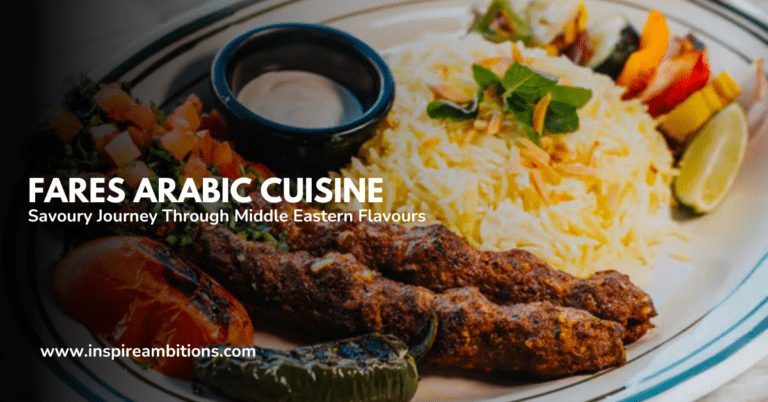アラビアの朝食 – 中東のおいしい朝の食事の紹介
Arabic breakfasts are an exquisite culinary experience that reflects the rich culture and history of the Middle East. These meals typically feature a variety of appetiser-style dishes known as mezze, including items such as eggs, vegetables, beans, labneh and more.
If you’re looking to expand your palate and explore these exotic flavours, you’re in for a treat.
In many Middle Eastern and Arab countries, breakfast carries significant cultural elements. It’s not just about the food itself; it also involves the atmosphere, the social aspect, and the bonding experience with family and friends.
As you start exploring Arabic breakfast, be prepared to embrace the vibrant colours, inviting aromas, and a wide array of textures that make this tradition a beloved part of daily life.
From popular dishes like Shakshuka and Falafel Sandwiches to lesser-known delicacies such as Fasoulia and Masoub, an Arabic breakfast offers something for everyone.
Every country and region has its unique specialities and distinct flavours, so dive into the world of these remarkable morning meals, and embark on an unforgettable culinary journey.
The Importance of Breakfast in Arabic Culture
Breakfast holds a significant place in Arabic culture, often seen as an opportunity for family and friends to come together and enjoy a variety of dishes rich in taste and tradition.
Your mornings in the Middle East may begin with a spread of mezze-style dishes that bring people closer as they share the delightful flavours of the region. As you explore the intricacies of Arabic breakfasts, you will find some common dishes on the table, reflecting the diverse and interconnected cultural influences.
You may encounter a medley of classic bites such as eggs, vegetables, beans, labneh, and hummus, each representing the interwoven nature of food and culture in the Middle East. By indulging in these delicacies, you immerse yourself in the customs and traditions that form an essential part of the Arabic way of life.
In addition to familiar dishes, you will also discover unique regional breakfast treats such as Manakish, a Levantine dough topped with thyme, cheese, or ground meat. The inclusion of falafel, za’atar, and fresh ingredients like cucumber, tomatoes, and olives further enrich your Arabian breakfast experience.
Tea plays a crucial role within Arabic breakfasts, often black tea infused with fresh mint and sugar, complementing the meal and promoting digestion.
Remember, when diving into the world of Arabic breakfasts, don’t hesitate to embrace the variety of flavours and textures that make up these culinary delights. By appreciating the essence of each ingredient, you can unravel the rich cultural heritage embedded within アラビア料理.
So, while you savour the fusion of ancient recipes and modern food trends, know that you are participating in a cherished cultural tradition that continues to resonate in today’s world.
Common Components of an Arabic Breakfast
An Arabic breakfast is known for its variety of appetiser-style dishes, also known as mezze, that combine different flavours and textures.
The following components are typically found in a traditional Arabic breakfast, offering you the opportunity to immerse yourself in the rich Middle Eastern culinary culture.
- Labneh: A tangy and creamy strained yoghurt, labneh is a popular addition to many Arabic breakfasts. It can be spread on bread or used as a dip for fresh vegetables.
- フムス: Made from chickpeas, tahini, olive oil, and lemon juice, this creamy dip is a staple Middle Eastern dish. You can enjoy hummus with pita bread, vegetable sticks, or even as a side dish accompanying main courses.
- Foul Mudammas: This hearty dish features fava beans that have been simmered with garlic, onion, and spices until thick and creamy. Some versions may include tomato, lemon juice, or chilli for an added kick.
- ファラフェル: These deep-fried balls made of chickpeas, fava beans, or a combination of both, are often seasoned with herbs and spices such as cumin and coriander. Falafel can be eaten on their own or stuffed into pita bread, making for a delicious breakfast sandwich.
- Pita Bread and Samoon: Both of these types of bread are commonly served during an Arabic breakfast. Pita is a thin, round bread, while samoon is a thicker, diamond-shaped loaf. Both can be used for scooping up dips or stuffing with various fillings.
- Shakshuka: A popular Middle Eastern dish that consists of poached eggs simmered in a spiced tomato sauce. It can be served with bread for dipping, making it a comforting and flavourful breakfast option.
- Za’atar Man’ouche: A type of flatbread topped with za’atar, a mixture of dried thyme, sumac, sesame seeds, and sometimes salt, this dish offers a savoury and slightly tangy taste, perfect for starting the day.
As you can see, an Arabic breakfast offers a diverse range of dishes that cater to different tastes and preferences. From creamy dips to spiced breads and hearty bean dishes, there is something for everyone in this Middle Eastern culinary tradition.
Enjoy the rich flavours and textures of a traditional Arabic breakfast, and discover how culture and cuisine are beautifully intertwined.
Diversity in the Arabic Breakfast
Levantine Breakfast
In the Levantine region, your breakfast may consist of a delicious combination of dishes such as foul mudammas そして フムス. Foul mudammas is an Egyptian dish with a base of fava beans and chickpeas, flavoured with cumin, lemon, and garlic.
It is enjoyed all across the Middle East as part of a traditional breakfast. Meanwhile, hummus, a smooth blend of chickpeas, tahini, lemon juice, and garlic, is not only enjoyed during breakfast but also throughout the day as a popular dip.
Falafel, another Levantine favourite, is a deep-fried ball made from ground chickpeas or fava beans and served with tahini sauce. Don’t forget to include some fresh salad, pickles, and warm pita bread to complete your Levantine breakfast experience.
North African Breakfast
As you move towards the North African region, your breakfast table may be graced with クスクス as a staple, rather than rice, which is more prevalent in the east. In this part of the アラブ世界, you might find dishes such as Shakshuka, a spicy blend of tomatoes, onions, and peppers with poached eggs on top.
Serve it with crusty bread and enjoy the North African flavours that have been developed over centuries of trading in ingredients.
Another popular dish for you to indulge in is Brik, a deep-fried pastry filled with tuna, egg, and various other fillings. A medley of fresh fruit or a side of yoghurt perfectly complements the bolder flavours of North African breakfast foods.
Gulf Breakfast
In the Arabian Gulf region, the Arabic dialects and preferences differ, even for breakfast. Here, you can enjoy a taste of traditional Emirati cuisines のように balaleet, a unique combination of sweet and savoury flavours with vermicelli noodles, sugar, and saffron custard, served with a layer of omelette on top.
Pair it with khameer, a slightly sweet and dense bread, and you have a satisfying and filling breakfast.
Another popular Gulf breakfast dish is chbaab, a pancake-like bread made with wheat and rice flour, yeast, sugar, and milk. These soft and fluffy pancakes are enjoyed with honey, date syrup, or even cheese for a delectable start to your day.
Overall, the rich culinary tapestry of the Arabic breakfast reflects the diverse regions of the Arab world. From the Levantine to the North African, and from the Gulf to the Mashreq, the variety of flavours, ingredients, and traditional dishes offers something delightful for everyone.
Popular Arabic Breakfast Dishes
Foul Medames
Foul Medames is a hearty Egyptian dish with a base of fava beans and chickpeas. Flavoured with cumin, lemon, and garlic, this dish is brightened up by fresh herbs and vegetables.
Although it originates from Egypt, Foul Medames is enjoyed as part of a traditional breakfast across the Middle East. When preparing this dish, you can opt for various versions that include tomato, lemon juice, or chilli, according to your taste preferences.
Shakshuka
Shakshuka is a well-known Middle Eastern breakfast dish consisting of eggs poached in a spiced tomato sauce. The sauce is typically made with chopped onion, diced bell pepper, cumin, and sometimes a combination of other spices.
This dish is perfect for a warm and filling breakfast, served alongside some crusty bread or pita to dip into the delicious sauce. The versatile nature of Shakshuka allows you to add other ingredients, such as beans or feta cheese, to suit your preference.
マナキーシュ
Manakeesh, also known as Zaatar Man’ouche, is a popular Levantine breakfast dish. It comprises a soft dough, similar to pizza, topped with a mixture of za’atar (a blend of thyme, sesame seeds, and sumac), olive oil, and occasionally other ingredients like cheese or ground meat.
This flavourful dish can be enjoyed as a warm morning meal, or even as a snack throughout the day. Variations in toppings and presentation can make Manakeesh a versatile and satisfying addition to your Arabic breakfast spread.
How to Prepare an Arabic Breakfast?
材料
To prepare a delightful Arabic breakfast, gather the following ingredients:
- Foul Mudammas: fava beans, chickpeas, cumin, lemon, garlic, fresh herbs, and vegetables
- 3 eggs
- 4 chunks of white cheese
- 20 olives (black or green)
- Za’atar spice mix
- 2 tomatoes
- 2 small cucumbers
- オリーブオイル
Steps to Create Arabic Breakfast
Follow these steps to create a satisfying Arabic breakfast:
- ファール・ムダンマス: Cook fava beans and chickpeas until tender. Combine them with cumin, lemon, and garlic for flavour. Add fresh herbs and vegetables to brighten the dish. You can enjoy Foul Mudammas as a protein-rich, traditional breakfast staple in the Middle East.
- 卵: Cook three eggs to your liking. You can make them scrambled, fried, or poached. Season the eggs with salt for taste.
- Cheese and Olives: Arrange four chunks of white cheese and approximately 20 olives on a plate. You can use sweet black Spanish olives or typical green olives as per your preference.
- Za’atar Seasoning: Sprinkle Za’atar spice mix over cheese and olives. This will add a unique and authentic flavour to your breakfast plate.
- 野菜: Slice two tomatoes and two small cucumbers. Arrange them on the plate as a fresh accompaniment to the other ingredients.
- Shakshouka (optional): As an alternative or additional egg dish, make Shakshouka. Sauté onions, diced tomatoes, and bell peppers in olive oil. Add canned beans to the mixture and crack eggs on top. Season with salt, and cook until the eggs are to your liking.
Serve your Arabic breakfast with warm bread for a complete and filling meal. Enjoy the medley of flavours and textures that make this breakfast a favourite across the Middle East.







